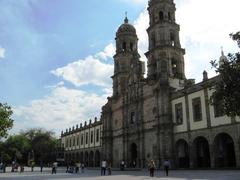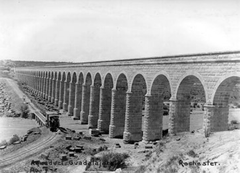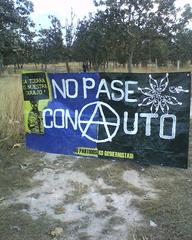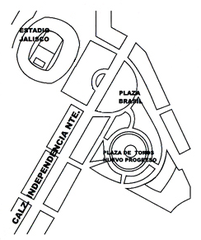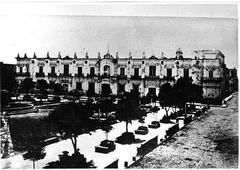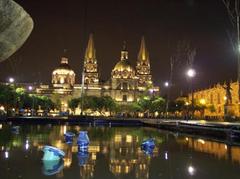Visiting Avenida Fray Antonio Alcalde in Guadalajara: History, Tips, and Highlights
Date: 31/07/2024
Introduction
Avenida Fray Antonio Alcalde is more than just a street in Guadalajara, Mexico; it is a cultural and historical artery that has played a significant role in the city’s development. Initially named Santo Domingo after the Dominican convent in the area, the avenue has undergone numerous transformations over the centuries, including a renaming to Avenida Catedral before finally being named in honor of Fray Antonio Alcalde in 1893 (El Occidental). Fray Antonio Alcalde was a revered bishop whose contributions to education and healthcare remain influential to this day (NTR Guadalajara). The avenue has evolved from a provincial street to a bustling urban center, now featuring a semi-pedestrian zone that has made it a vibrant space for cultural events and communal activities (Vagabunda). This guide aims to provide a comprehensive overview of Avenida Fray Antonio Alcalde’s history, key landmarks, visitor tips, and its cultural significance to help you make the most of your visit.
Table of Contents
- Introduction
- History of Avenida Fray Antonio Alcalde
- Key Landmarks and Attractions
- Visitor Information
- Nearby Attractions and Accessibility
- Cultural and Historical Significance
- Recent Developments
- Impact on Local Community
- Future Prospects
- FAQ
- Conclusion and Call to Action
History of Avenida Fray Antonio Alcalde
Early History and Naming
Avenida Fray Antonio Alcalde, one of Guadalajara’s most significant thoroughfares, has a rich history that dates back to the 17th and 18th centuries. Initially, this avenue was known as Santo Domingo, named after the Dominican convent located in what is now the Jardín de la Reforma and the Templo de San José de Gracia (El Occidental). This name reflected the religious and cultural influence of the Dominican order in the area.
In subsequent years, the avenue was renamed “Catedral” due to its proximity to the Guadalajara Cathedral. However, in 1893, the avenue was officially named Avenida Alcalde to honor Fray Antonio Alcalde, a significant figure in the city’s history (El Occidental).
Transformation Over the Centuries
The avenue has undergone numerous transformations over the centuries. During the gubernatorial period of José de Jesús González Gallo (1947-1953), significant changes were implemented to improve traffic flow in the city center. Architect Ignacio Díaz Morales was commissioned to redesign the area, which involved the demolition of several old structures to make way for modern infrastructure (El Occidental).
Modernization and Pedestrianization
In recent years, Avenida Fray Antonio Alcalde has seen a significant shift towards pedestrianization. This transformation was part of a broader initiative to enhance the urban environment and prioritize pedestrian and cyclist traffic. The project was closely linked to the construction of Line 3 of the Tren Eléctrico, which provided an opportunity to reimagine the avenue as a pedestrian-friendly corridor (Reporte Indigo).
The modernization project, initiated by the government of the late Aristóteles Sandoval Díaz, included plans for a vehicular tunnel and a two-level underground parking facility. Although these specific elements were eventually canceled, the overall goal of reducing vehicular traffic and creating a more pedestrian-friendly environment was achieved (Reporte Indigo).
Key Landmarks and Attractions
Guadalajara Cathedral
The Guadalajara Cathedral, also known as the Catedral Basílica de la Asunción, is the most prominent landmark along Avenida Fray Antonio Alcalde. The cathedral’s construction began in 1573, and it was dedicated in 1618. It achieved the status of a metropolitan cathedral in 1863 and has served as the seat for numerous bishops and archbishops (Fundación Paseo Fray Antonio Alcalde).
Rotonda de los Jaliscenses Ilustres
Located near the cathedral, the Rotonda de los Jaliscenses Ilustres is a monument dedicated to the illustrious figures of Jalisco. It features 30 bronze sculptures of the state’s most celebrated writers, architects, and other notable personalities (Lonely Planet).
Plaza de Armas
Plaza de Armas is another significant landmark along the avenue. This plaza is a popular spot for people-watching and enjoying the view of the cathedral, especially at dusk when the lights illuminate the area (Playas y Plazas).
Visitor Information
Visiting Hours and Tickets
The avenue is accessible 24/7, but specific landmarks like the Guadalajara Cathedral have their own visiting hours. The cathedral is typically open from 7:00 AM to 8:00 PM. There is no charge to stroll along the avenue or visit many of its outdoor landmarks. However, entry fees may apply for specific attractions like the cathedral or nearby museums.
Travel Tips
Comfortable walking shoes are recommended due to the pedestrian nature of the avenue. Public transportation options, including the Tren Eléctrico, make it easy to reach the area.
Nearby Attractions and Accessibility
Avenida Fray Antonio Alcalde connects several iconic landmarks in Guadalajara, making it a perfect starting point for exploring the city’s historical sites. Nearby attractions include the Hospicio Cabañas and the Instituto Cultural Cabañas, both UNESCO World Heritage sites. The avenue is wheelchair accessible, and various amenities are available for visitors with disabilities.
Cultural and Historical Significance
Avenida Fray Antonio Alcalde is not just a transportation route; it is a cultural and historical artery that connects some of Guadalajara’s most iconic landmarks. The avenue passes by the Santuario de Nuestra Señora de Guadalupe, La Casa de los Perros, the Rotonda de los Jaliscenses Ilustres, the Guadalajara Cathedral, and the Plaza de Armas (El Occidental).
The Guadalajara Cathedral, a key landmark along the avenue, is a testament to the city’s rich architectural heritage. Begun in 1561 and consecrated in 1618, the cathedral features distinctive neo-Gothic towers that were rebuilt after an earthquake in 1818 (Lonely Planet). The cathedral has been a focal point for many significant events in the city’s history, including visits from notable figures such as Miguel Hidalgo and Pope John Paul II (Fundación Paseo Fray Antonio Alcalde).
Recent Developments
The most recent phase of development for Avenida Fray Antonio Alcalde was completed in 2020, coinciding with the addition of a new metro line running in front of the cathedral. This latest renovation has further enhanced the pedestrian experience, making it easier and more enjoyable to explore the historic core of Guadalajara (Playas y Plazas).
The transformation of Avenida Fray Antonio Alcalde into a pedestrian-friendly space has had a positive impact on local businesses and the overall urban environment. The avenue now boasts a variety of shops, cafes, and cultural attractions, making it a vibrant and dynamic part of the city (El Occidental).
Impact on Local Community
The transformation of Avenida Fray Antonio Alcalde has had a profound impact on the local community. The pedestrianization project has not only improved the urban environment but also boosted local businesses by increasing foot traffic. The avenue now serves as a vibrant public space where residents and visitors can enjoy cultural events, shopping, and dining (El Occidental).
Future Prospects
Looking ahead, Avenida Fray Antonio Alcalde is poised to continue its evolution as a key cultural and historical corridor in Guadalajara. Ongoing efforts to preserve and enhance the avenue’s heritage, combined with modern urban planning initiatives, will ensure that it remains a vital part of the city’s landscape for years to come (Reporte Indigo).
FAQ
Q: What are the visiting hours for Avenida Fray Antonio Alcalde?
A: The avenue itself is accessible 24/7, but individual landmarks like the Guadalajara Cathedral have specific visiting hours, typically from 7:00 AM to 8:00 PM.
Q: Are there any entry fees for visiting landmarks on Avenida Fray Antonio Alcalde?
A: There is no charge to stroll along the avenue or visit many of its outdoor landmarks. However, entry fees may apply for specific attractions like the cathedral or nearby museums.
Q: What are the main attractions along Avenida Fray Antonio Alcalde?
A: Key attractions include the Guadalajara Cathedral, Rotonda de los Jaliscenses Ilustres, and Plaza de Armas.
Conclusion and Call to Action
Avenida Fray Antonio Alcalde’s rich history and recent transformations make it a must-visit destination for anyone exploring Guadalajara. Its blend of historical landmarks, cultural significance, and modern amenities offers a unique and enriching experience for all visitors. Be sure to explore this vibrant avenue, and don’t forget to check out other related posts and follow us on social media for more updates!
References
- El Occidental, Como ha cambiado la avenida Fray Antonio Alcalde a lo largo del tiempo, 2022, El Occidental
- Reporte Indigo, Paseo Alcalde: Así fue el plan original de la transformación del centro histórico de Guadalajara, 2020, Reporte Indigo
- Fundación Paseo Fray Antonio Alcalde, Catedral de Guadalajara, 2021, Fundación Paseo Fray Antonio Alcalde
- Lonely Planet, Catedral de Guadalajara, 2021, Lonely Planet
- Playas y Plazas, Downtown Guadalajara (Centro Historico), 2022, Playas y Plazas
- Vagabunda, Avenida Alcalde: de calle provinciana a arteria principal de Guadalajara, 2021, Vagabunda
- NTR Guadalajara, Fray Antonio Alcalde y Barriga, 2021, NTR Guadalajara
- Mexico Travel Secrets, Things to Do in Guadalajara, Mexico, 2022, Mexico Travel Secrets
